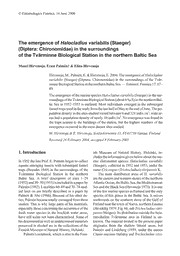
The emergence of Halocladius variabilis (Staeger) (Diptera: Chironomidae) in the surroundings of the Tvärminne Biological Station in the northern Baltic Sea PDF
Preview The emergence of Halocladius variabilis (Staeger) (Diptera: Chironomidae) in the surroundings of the Tvärminne Biological Station in the northern Baltic Sea
©EntomologicaFennica.16June2006 The emergence of Halocladius variabilis (Staeger) (Diptera: Chironomidae) in the surroundings of the Tvärminne Biological Station in the northern Baltic Sea MauriHirvenoja,ErnstPalmén†&ElinaHirvenoja Hirvenoja,M.,Palmén,E.&Hirvenoja,E.2006:TheemergenceofHalocladius variabilis (Staeger) (Diptera: Chironomidae) in the surroundings of the Tvär- minneBiologicalStationinthenorthernBalticSea.—Entomol.Fennica17:87– 89. TheemergenceofthemarinespeciesHalocladiusvariabilis(Staeger)inthesur- roundingsoftheTvärminneBiologicalStation(about6‰S)inthenorthernBal- ticSeain1952–1953isoutlined. Mostindividualsemergedinthesubmerged funneltrapsusedinthestudyfromthelasthalfofMaytotheendofJune.Thepo- pulationdensityinthesitesstudiedvariedbetween0and328indiv./m2;widear- eashadapopulationdensityofnearly10indiv./m2.Noemergencewasfoundin thetrapsnearesttothebuildingsofthestation,butthehighestnumbersofthe emergenceoccurredinthemostdistantsitesstudied. M.Hirvenoja&E.Hirvenoja,Sotilaskorventie13,FI-01730Vantaa,Finland Received26February2004,accepted8February2005 1.Introduction ish Museum of Natural History, Helsinki, in- cludestheinformationgivenbelowaboutthema- In1952thelateProf.E.Palménbegantocollect rine chironomid species Halocladius variabilis aquaticemerginginsectswithsubmergedfunnel (Staeger),collectedin1952and1953,underthe traps (Brundin 1949) in thesurroundings ofthe nameCricotopus(Trichocladius)vitripennisK. Tvärminne Biological Station in the northern The main distribution areas of H. variabilis Baltic Sea. A brief description of sites 1–29 aretheeasternandwesternshoresofthenorthern (1952)and30–50(1953)isincludedinapaperby AtlanticOcean,theBalticSea,theMediterranean Palmén(1962).Localities60–69and70–78stud- SeaandtheBlackSea(Hirvenoja1973).Itisone ied later on are briefly described in a paper by ofthefewmarinespeciesinFinlandandtheonly Palmén&Aho(1966).Becauseofhisotherdu- speciesofthisgenusintheBalticSea.Itoccurs ties,Palménbecametotallyestrangedfromthese northwardsonthesouthernshoreoftheGulfof studies.Thisiswhylargepartsofhismaterials, FinlandnearthetownofNarva,northernEstonia especiallythoseconcerningtheoccurrenceofthe (Järvekülg1979:Fig.66,subTrichocladiusvitri- fresh water species in the brackish water areas, pennisMeigen).Itsdistributionoutsidethebeta- havestilltodaynotbeencharacterised.Someof mesohaline Tvärminne area in Finland is un- hisdeterminedaswellasundeterminedmaterials known.Thematerialtreatedinthepresentpaper preservedinalcoholareinthecollectionsofthe originates from the shallow littoral areas, but FinnishMuseumofNaturalHistory,Helsinki. Palmén and Lindeberg (1959, under the names Palmén’snotebook,whichisalsointheFinn- CluniomarinusHalidayandTrichocladiusvitri- 88 Hirvenojaetal. (cid:127) ENTOMOL.FENNICAVol.17 Fig.1.ThesumofthedailyemergenceofHalocladiusvariabilis(Staeger)inthe Tvärminneseaareain1952and1953basedon29or30submerged0.25m2funnel traps,respectively.Darkcolumns,females;whitecolumns,males. pennis Meigen) reported that pupal exuviae of H.variabiliswereinthesurroundingsofthenear- H.variabilisoccurveryregularlyinthesamesur- est islands Vikaskär and Jovskär opposite to face samples, where Clunio balticus Heimbach Krogarviken Bay. At that time, the Biological wasfoundinareasmorethan10mdeep.Incon- Stationhadnowastewaterpurifyingplant.This trasttoH.variabilis,thelatterspeciesisveryrare situation may have had some influence on the inshallowerareas. aquaticbiota. H.variabilishasnotbeenfoundinfreshwater Unfortunately,noinformationisavailablefor habitats,butSanthakumaranetal.(1984)report, thewaterchemistryintheTvärminnearea1952– that the larvae were unaffected when placed in 1953. Traps were also set in summer 1953 in distilled water and could withstand salinities as someofthesitesstudiedin1952(1–2,12–13a–b, high as 70.5 ‰ when transferred directly from 27–29),butsites30–51werenew.Nosubsequent distilledwaterand97.0‰afteracclimation.Ac- emergenceofH.variabiliswasobservedin1953 cordingtothoseauthorsthelarvaewerepresent in Krogarviken Bay or in traps 34–37 near the inTrondheimsfjorden,Norway,amongavariety shoreofJovskärisland. offoulingcommunitiesrangingfromathinfilm Thehighestpopulationdensityin1953wasat ofalgaeandsilttoextremelyheavysettlementsof sites 45–47, at the eastern tip of Longholmen coelenterates, serpulids, barnacles, bivalves, about700–800mfromthebuildingsoftheBio- bryozoans, ascidians, or algae together with a logicalStation.Atsite45(depth6m)thedensity thicklayerofsiltandfaecesofpolychaetes,as- can be converted from the emergence to 328 cidians,andwood-borers. indiv./m2.Thenearesttraps,46and47(depths12 and13m),producedsmallercatches.Thevertical distributionofthelarvaeisnotknownintheBal- 2.PopulationdensityatTvärminne ticSea.Mostofthesitesstudiedin1953wereata basedontheemergence greaterdistancefromtheBiologicalStationthan those in 1952, and the mean catch in 1953 was Therewereatotalof29funneltrapseach0.25m2 higher,being23.6indiv./m2. inarea,usedin1952and30trapsin1953atthe sitesneartheBiologicalStation.Theyarenum- bered in the map given by Palmen (1962). The 3.PhenologyofH.variabilis population density of H. variabilis was low in intheTvärminneseaarea 1952withamaximumof5indiv./0.25m2(=20 indiv./m2).Atthe15sites(=traps)whereemer- As mentioned above, the population density of gencewasobserved,themeanpopulationdensity H. variabilis was very low in most of the sites canbeconvertedto10.4indiv./m2. studied.Therefore,thedaily catchesofalltraps Intraps1–6,8–12and27–28noindividuals arecombinedintothehistogramsinFig.1,where emergedin1952.Sites1–6inKrogarvikenBay inbothyearsthetotalcatchoriginatedfrom29or (depths 1–7 m) that has abundantly vascular 30(1953)traps(each0.25m2),i.e.thedailycol- plantswerenearesttotheStationbuildings.The umnsarethesumsofcatchesfromtotalareasof othersites8–12and27–28withoutemergenceof 7.25or7.50m2.Theseareasalsoincludethetraps ENTOMOL.FENNICAVol.17 (cid:127) EmergenceofH.variabilisinBalticSea 89 (sites)wheretheemergenceofH.variabiliswas Kenntnis der Bodenfaunistischen Characterzüge notobserved. schwedischeroligotropherSeen.[WithEnglishsum- mary].—Inst.Freshw.Res.Drottningholm,Rep.30: Theoccurrenceoftwoormoreemergencepe- 1–914. riodsduringaseasonisaquitecommonphenom- Hirvenoja,M.1973:RevisionderGattungCricotopusvan enoninthelifecycleofthelittoralchironomids. derWulpundihrerVerwandten(Diptera,Chironomi- Fig.1showsthatthepopulationofH.variabilis dae).—Ann.Zool.Fennici10:1–363. in the Tvärminne sea area is univoltine. It Järvekülg,A.1979:Thebottomfaunaofeasternpartofthe BalticSea.[InRussian].—382pp.Valgus,Tallinn, emergesfromthelasthalfofMay totheendof Estonia. June,perhapswhenthebottomwatertemperature Palmén,E.1962:Studiesontheecologyandphenologyof isabove+4°Candthesurfacewatertemperature the Chironomids (Dipt.) of the Northern Baltic. 1. exceeds about +8°C (see Fig. 13 in Palmén & Allochironomus crassiforceps K. — Ann. Entomol. Aho1966:thedevelopmentofthetemperaturein Fennici28:137–168. Palmén,E.&Aho,L.1966:Studiesontheecologyand 1960). There happened also occasional emer- phenologyoftheChironomidae(Dipt.)oftheNorth- gences in the Tvärminne population during the ern Baltic. 2. Camptochironomus Kieff. and Chiro- othersummermonths. nomusMeig.—Ann.Zool.Fennici3:217–244. Palmén, E. & Lindeberg, B. 1959: The marine midge, Acknowledgements.ThanksareduetoMr.DonaldSmart CluniomarinusHal.(Dipt.,Chironomidae),foundin forrevisionofthelanguage. BrackishwaterinthenorthernBaltic.—Int.Rev.Ges. Hydrobiologie44:383–394. Santhakumaran,L.N.,Sneli,J.-A..&Sundnes,G.1984: References The larvae of (Halocladius (Halocladius) variabilis (Diptera: Chironomidae) from the fouling assem- Brundin,L.1949:ChironomidenundandereBodentiere blages on wooden test panels submerged in Trond- derSüdschwedischenUrgebirgseen.EinBeitragzur heimsfjorden.—Sarsia69:155–158.
